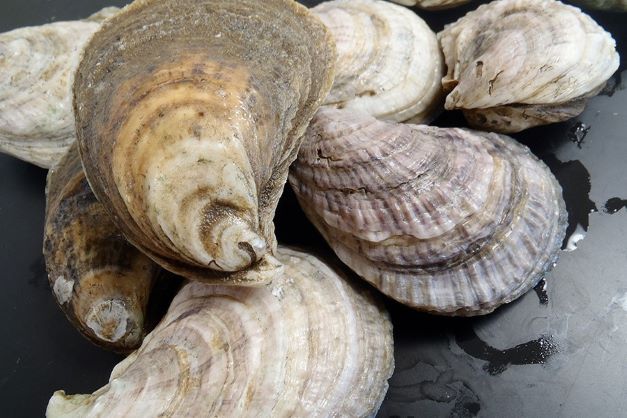PHOTO: Oysters harvested in Liberia
Perry Raso, proprietor of Matunuck Oyster Bar, a leading seafood center based in the United States of America, has donated several pieces of fishing gears to a group of Liberian fishers, who primarily venture into the harvesting of oyster without the needed fishing gears.
The group of fisherfolks located in Monrovia’s Slipway Community, harvests oysters from the Du River, a body of water misused by residents for dumping of wastes including excreta, a press release from NaFAA said.
The items donated are boots, gloves and t-shirts.
The presentation was made on behalf of Perry Raso by National Fisheries and Aquaculture Authority Deputy Director General for Technical Services, William Y. Boeh. Presenting the items, Mr. Boeh said the donation was the first of three interventions in oyster fish farming. Boeh said the gift is the outcome of a visit made to Liberia by Perry and his colleague.
“On behalf of my boss, Hon. Emma Metieh Glassco, I want to take this time to present this donation from Perry and his team in the United States of America through Senator Darius Dillon office. Last year, Perry and Terrance conducted interviews here and at the end they report on three interventions they want to make. The first and the short-term intervention is to present these things to you”.

Mr. Boeh encouraged the oyster fisherfolks to use the donated items for the intended purpose.
Receiving the items on behalf of the Slipway oyster fishers, Isaac W. Wallace, head of the group lauded the donor and NaFAA for the donation. He promised to work with NaFAA and other partners for the development of fisheries in Liberia.
In an interview earlier, Perry said his intervention followed a survey conducted in Liberia in 2021 on the future and commercial viability of oyster. According to Perry, he visited Du, St. Paul and Farmington Rivers in Montserrado and Margibi Counties respectively.
Mr. Perry mentioned he found that the fisherman at Slipway harvest blood arks (senilia senilis) and oysters (Crassostrea virginica) as a secondary job, with their primary job being in construction or as fisherman in other fisheries.
Perry said: “The product was sold in the shell, not shucked and they receive a somewhat stable price between six and ten USDs per full bucket. The arks and oysters are sold by the bucket, which are approximately one gallon of volume. Women that were seen selling the ark clams at the market reported to be selling
them for $2.50 dollars for approximately one pint (groupings pictured below). There were no oysters being sold at the markets. Some seasonal fluctuation in the price and year-round demand was reported”.
Perry noted that the fisherman reported it takes between three to four hours to harvest four to five buckets, and they do not harvest during the rainy season because the water is too high.
“No mollusks of any kind were visible on the mangrove roots or rocks in the submerged shoreline. Fisherman at both the Du River and St. Paul River reported that during dry season when water is low is when oysters and other bivalves are harvested, however none were visible at the time of the visit in early October”.
He revealed his donation was based on needs assessment of the Slipway fishermen.
“The fisherman reported that harvesting oysters resulted in them cutting their hands and feet, and are in need of gloves and footwear which are not available at the outlet where they purchase their fishing equipment.
“A short-term goal would be to get boots and gloves for the fisherman to allow them to safely harvest shellfish. In turn, perhaps we can ask the fisherman if they can take pictures and document the areas where there are wild assemblages of oyster set during the dry season which will help determine where spat collectors might be most suitable. Long term goals would be to introduce spat collectors (pictured below) to determine settlement and then come up with a cage system to hold the animals until they reach market size using readily available materials”.
Matunuck Oyster Bar is considered one of the best Oyster bars in the U.S. the bar grows its own oysters and vegetables; creating signature dishes tied to New England seasons.
Oysters are an excellent source of zinc, iron, calcium, and selenium, as well as vitamin A and vitamin B12. Oysters are low in food energy; one dozen raw oysters provides only 460 kilojoules (110 kilocalories). They are rich in protein (approximately 9 g in 100 g of Pacific oysters).[57] Two oysters (28 grams or 1 ounce) provide the Reference Daily Intake of zinc and vitamin B12.[58]
Traditionally, oysters are considered to be an aphrodisiac, partially because they resemble female sex organs.[59] A team of American and Italian researchers analyzed bivalves and found they were rich in amino acids that trigger increased levels of sex hormones.[60] Their high zinc content aids the production of testosterone.

